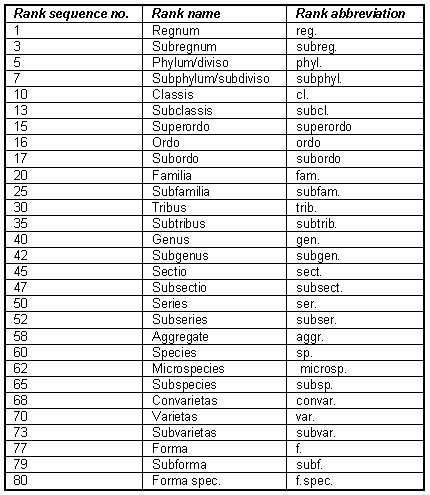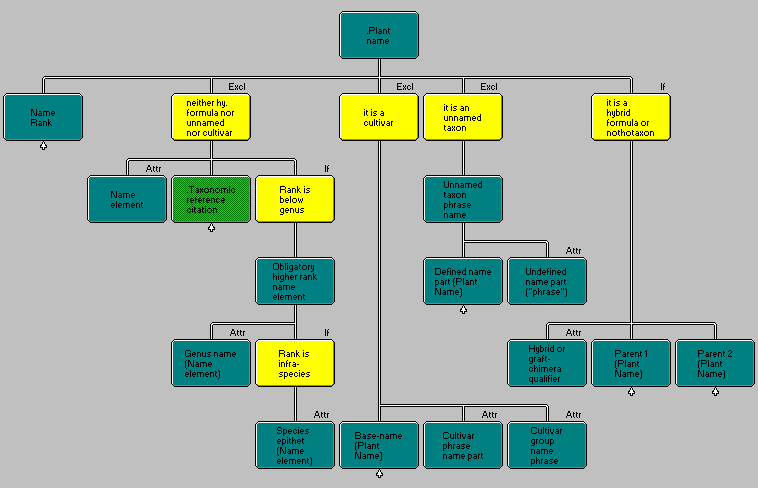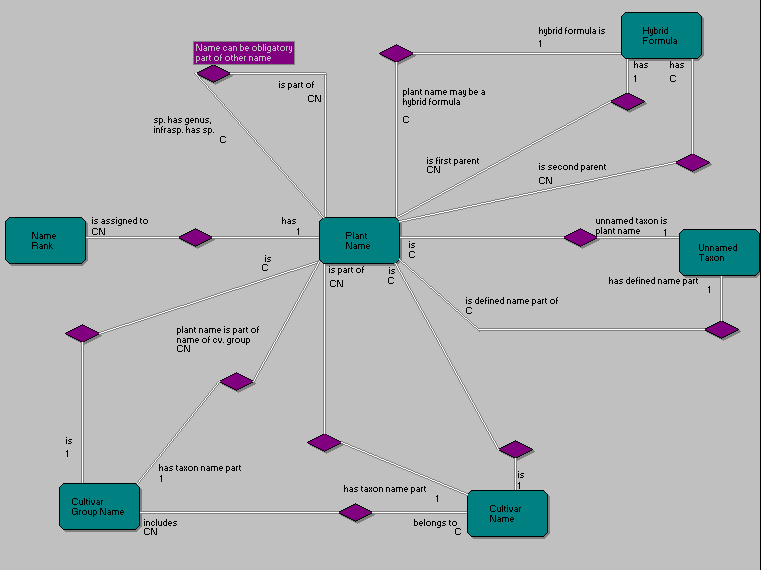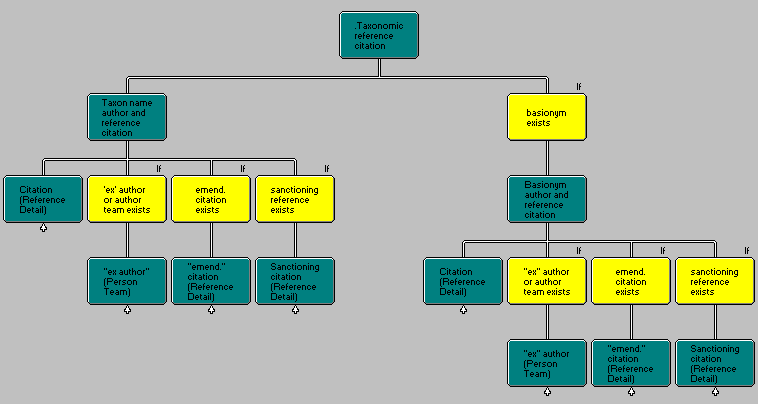
A botanical name is here defined as consisting of either
or of
or of
or of
In addition, all botanical names need a designation of the taxonomic rank, which may or may not be cited with the name (obligatory in the case of infraspecies and for taxa in-between species and generic rank).
All names fulfilling these prerequisites may be entered in the database, independent of any taxonomic or nomenclatural judgment passed on them. Relationships and attributes which represent such judgment are not included in nor directly related to the entity „Plant Name". They are expressed in relation to a potential taxon, which allows to cite and keep the source of the information. For example, in the case of the incorrect assignation of a basionym by one author, the error is referred to the potential taxon created by the recording of that author's judgment. This is to correctly model the real-world situation: Although without doubt a single correct statement exists, this is often not yet reflected in what a specific author states.
Every name has a rank. The rank pointer itself is a sequential number which serves for sorting purposes. It is not possible to change the rank of a name, except by creating a new name and a potential taxon name referring to it.

Table 1: Attributes in the Rank Table and their values
Note: Ranks numbered > 80 need integrity rules as to which higher ranks or special name structures (nothomorph!) they may refer to.
The database program has to create botanical names by a process of concatenation of data items from various tables. The actual process varies according to the structure of the name; retrieval of a genus name, for example, is functionally different from retrieval of a hybrid formula or of an infraspecific taxon. To facilitate this process, the entity type Plant Name includes the attribute „NameStruct" to specify the structure of the name, although the structure of the name might also be computed from other attributes (e.g. a name with genus rank and filled in name element must be a monomial, a name with the hybrid flag set and an empty name element attribute must be a hybrid formula, etc.).

Table 2: Allowed values for attribute NameStruc (Name Structure)
Every record in the entity „Botanical Name" includes exactly one name element, so that binomials and trinomials require a pointer to the obligatory higher ranked name part (i.e. a pointer to a species for an infraspecific epithet as the name element, and a pointer to a genus for elements belonging to a binomial). Although this hierarchy represents an element of classification, it is kept here completely apart from the classification in the systematic sense. The latter is based on potential taxa while the former represents a "grammatical" rule which must be solved in the "Plant Name" entity. However, integrity rules must ensure that the two hierarchies do not conflict.
Aggregates and „sensu lato" taxa in floras have been created by taxonomists to avoid a clear decision on the taxon in question; recognizing that there is doubt as to the segregates (microspecies, included species) do or do not exist as separate taxa or recognizing that a consensus on the species concept cannot be reached. The botanical code does not include provisions as to how to formally handle these terms, and disagreement exists within the taxonomic community as to their true value and significance.
Since aggregates and the likes have been and still are used in taxonomic literature, the data model must provide for them. The solution here followed is to include Aggregate and Microspecies as "ranks" immediately adjacent to the species and use the classification intersection to provide the necessary link (see chapter 4). A possible alternative would be a separate entity linking aggregates and microspecies, but apart from a slight advantage in integrity enforcement, no immediate advantage is derived from that.
Integrity rules for the aggregate/microspecies relationship include:
Following the "Cultivated Code" (Brickell & al. 1980), the Cultivar (from cultivated variety) is the lowest recognized category of names of cultivated plants. The cultivar's name, similar to that of an unnamed taxon, consists of a botanical name as governed by the International Code of Botanical Nomenclature and an additional phrase (cultivar name), which in this case may (and, since 1959, must) consist of non-latinized words. The full name of the cultivar is formed by the botanical name followed by the cultivar name, which should consist of no more than 3 words. The latter should preferably be enclosed in single quotation marks, alternatively it may be cited following the abbreviation "cv.".
A collective epithet in modern language (article 18, "Cultivated Code") or the name of a cultivar group (article 26) may be intersected in parenthesis before the cultivar name.
It should be noted, however, that the "Cultivated Code" has been the source of many controversies, and that strong efforts are under way to come to a different system of nomenclature in this area.
The data model closely follows the rules and recommendations given in appendix I of the Tokyo Code (Greuter et al. 1994). Hybridity is indicated by an attribute in the „Botanical Names" entity (attribute "HybridQual"). This marker may also be used to indicate graft chimaera and somatic hybrids, which are supposed to essentially follow the same structural rules as hybrids.

Table 3: Allowed values for attribute HybridQual (Hybrid Qualifier)
Hybrid formulas are expressed by a relationship to the entity „Hybrid Formula" which in turn points to two plant names (the parents). The parents themselves may be hybrid-formulas, so that multiple parentage can be expressed. Hybrid formulas must have an entry in the „Hybrid Formula" entity, providing pointers to both parents, while the attribute „Name Element" in the „Plant Name" entity must remain empty.
In contrast, Nothotaxa (named hybrids) have the latter attribute filled in. They can have an entry in the „Hybrid Formula" entity, which should point to one or two parents. (Article H 3.2 of the Code prescribes at least one known or postulated parent for the designation of a nothotaxon.)

Diagram 3: Data structure of botanical names
(Note: Nothotaxa may include a "normal" name structure in addition to the hybrid-specific attributes, therefore the "hybrid formula or nothotaxon" condition is non-exclusive)
These are taxa recognized by a taxonomist which have not yet been named, but which can be preliminaryly designated by a name phrase (for example, a herbarium specimen citation and/or a location description).
It may seem frivolous to introduce a naming convention for unnamed taxa. However, particularly the Australian members of the ISC pointed out that up to a third of the taxa present in Australia may belong to this category. Unnamed taxa are here accepted only at a rank below the generic level; the name phrase must therefore always be combined with a plant name of appropriate rank.
The following diagram summarizes the entities used to express the data structures detailed in Diagram 3.

Diagram 4: Entity Relation Diagram for Botanical Names
(Relational integrity as given by cardinality in diagram.)

Diagram 5: Taxonomic Reference Citation
Monomials, binomials, and trinomials have at least one author or author team assigned to them, the author(s) of the name itself. In the case of names which have been altered in rank, the authors of the basionym are to be cited as well (Tokyo Code, art. 49). In addition, „ex-authors" (the author or team a name was ascribed to, i.e. the name(s) preceding the "ex"), as well as „in-" and „emend.-" citations may be present.
In the model, the true character of the author citation as a bibliographic reference is directly mirrored. All taxonomic author citations are treated as links to a reference detail (exact page citation) which points to a reference title, which in turn has author(s). The only exemption are the „ex" authors, which are no authors in the bibliographical sense. In case that the exact citation is unknown, a dummy reference pointing to the respective author team has to be inserted in both entities, "Reference Detail" and "Reference Title". Management of dummy references has to be provided by the user interface program.
For details of references, author teams etc. and for the respective ER-model, please refer to the treatment of person teams and bibliographic references (chapter 5).
Next chapter; Contents of this article; Complete entity list; References cited; Author information. Last updated: June 23, 1995